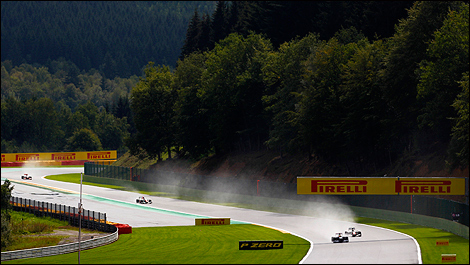Aug
27th
Stay connected Subscribe to our RSS feed
From Pirelli
Pirelli returns to action at the Belgian Grand Prix this weekend with the P Zero silver hard tire and white medium: a combination that has not been raced since the second event of the season in Malaysia.
The conditions at the legendary Spa-Francorchamps circuit will be somewhat different however. The 7.004-kilometre lap is the longest of the entire year by some margin, and this is just one of the factors that can lead to extremely variable weather conditions, with a high risk of rain.
Set within the Ardennes forests, Spa's geography also ensures that it has its own microclimate, meaning that it can often be raining on one part of the circuit but be completely dry on another part.
The track is renowned for its high speeds and fast corners. It is also challenging on the tires, which have to cope with extremely high lateral and longitudinal energy loadings, thanks to fearsome compressions such as Eau Rouge: a corner that feels like the ultimate roller-coaster ride.
In Eau Rouge, compression each front tire is subjected to a maximum peak of vertical loads of more than 1000kg - one tonne.
With all the compressions at Spa, getting the ride height and suspension travel correct is vital as otherwise the cars could bottom out at some parts of the circuit. The tire forms a vital component of the car's suspension, with the deformation of the rubber under load making up nearly half a Formula One car's total suspension travel.
The cars are at full throttle in Spa for nearly 75% of the lap, which makes it one of the quickest circuits of the year together with Monza - which takes place the following weekend. The high speeds increase tire temperature, particularly if an aggressive camber set-up is adopted to maximize grip.
Pirelli returns to action at the Belgian Grand Prix this weekend with the P Zero silver hard tire and white medium: a combination that has not been raced since the second event of the season in Malaysia.
The conditions at the legendary Spa-Francorchamps circuit will be somewhat different however. The 7.004-kilometre lap is the longest of the entire year by some margin, and this is just one of the factors that can lead to extremely variable weather conditions, with a high risk of rain.
Set within the Ardennes forests, Spa's geography also ensures that it has its own microclimate, meaning that it can often be raining on one part of the circuit but be completely dry on another part.
 |
| Photo: Pirelli |
The track is renowned for its high speeds and fast corners. It is also challenging on the tires, which have to cope with extremely high lateral and longitudinal energy loadings, thanks to fearsome compressions such as Eau Rouge: a corner that feels like the ultimate roller-coaster ride.
In Eau Rouge, compression each front tire is subjected to a maximum peak of vertical loads of more than 1000kg - one tonne.
With all the compressions at Spa, getting the ride height and suspension travel correct is vital as otherwise the cars could bottom out at some parts of the circuit. The tire forms a vital component of the car's suspension, with the deformation of the rubber under load making up nearly half a Formula One car's total suspension travel.
The cars are at full throttle in Spa for nearly 75% of the lap, which makes it one of the quickest circuits of the year together with Monza - which takes place the following weekend. The high speeds increase tire temperature, particularly if an aggressive camber set-up is adopted to maximize grip.
 The latest auto news, reviews, prices, product and vehicle releases.
The latest auto news, reviews, prices, product and vehicle releases.